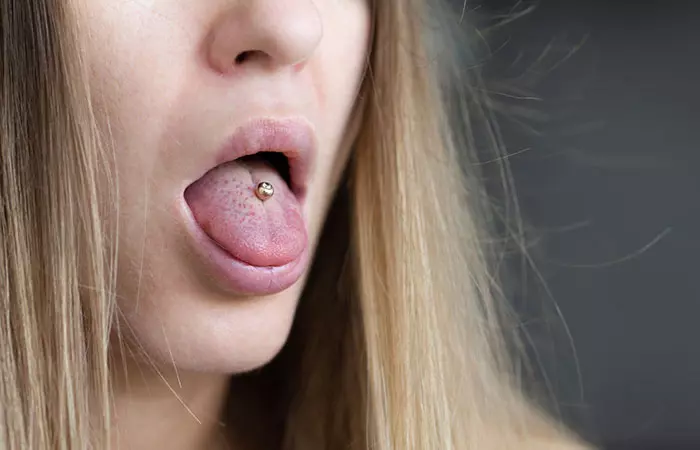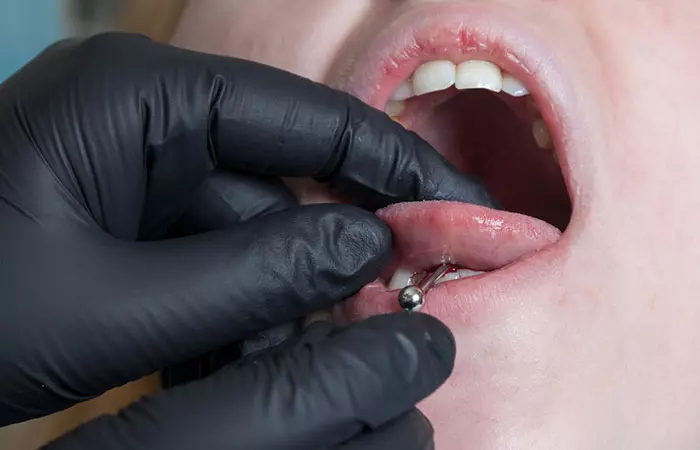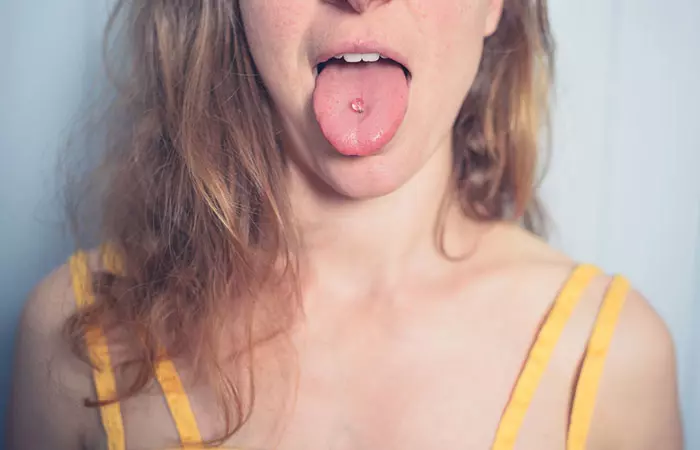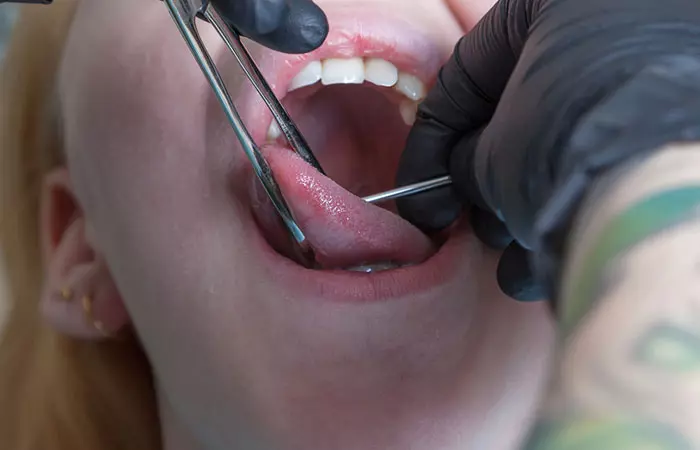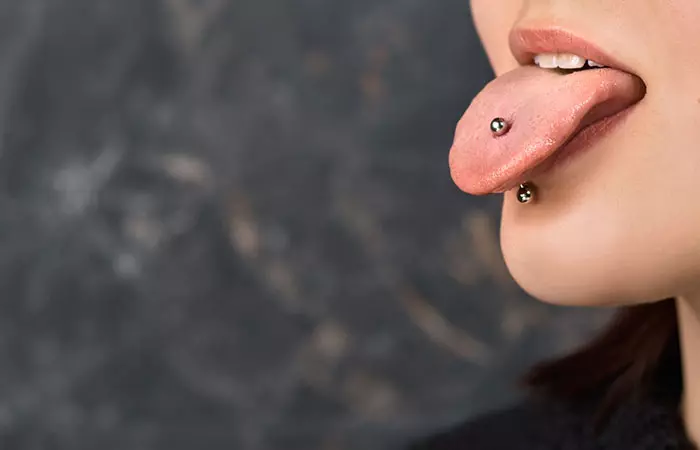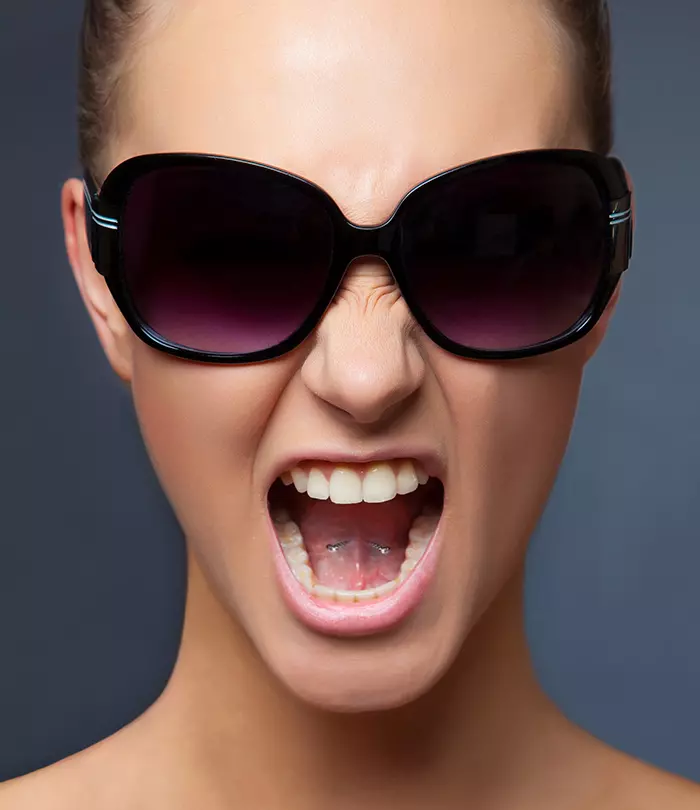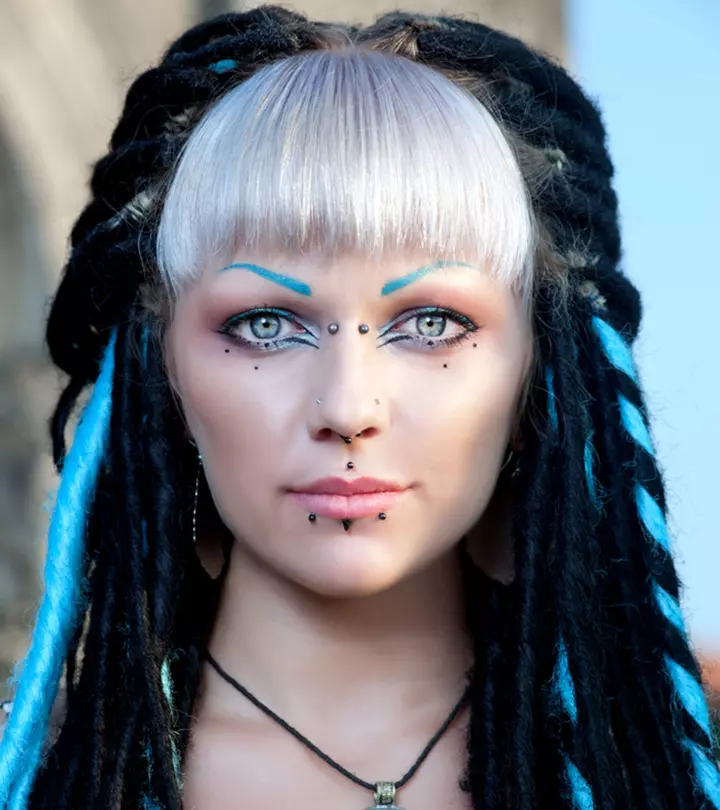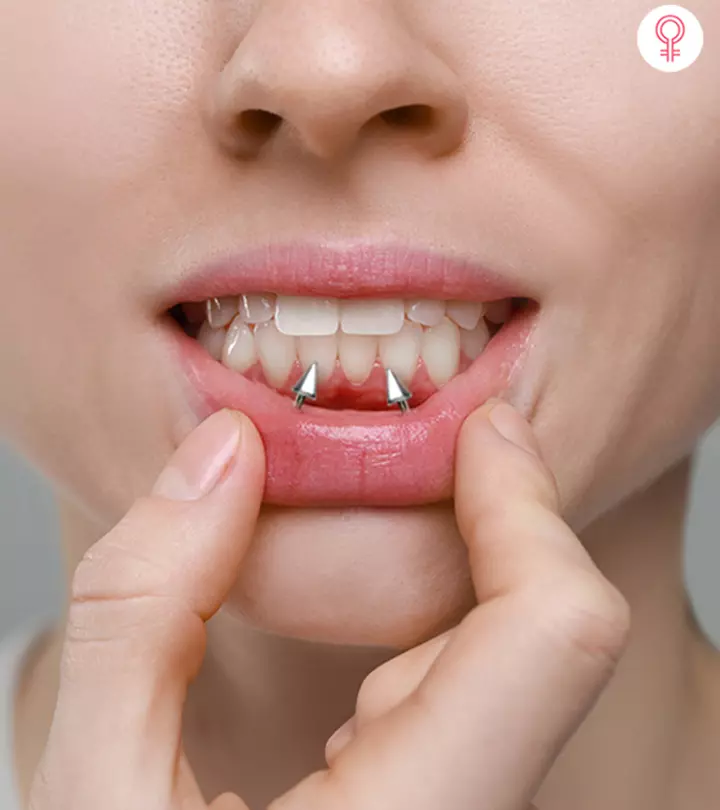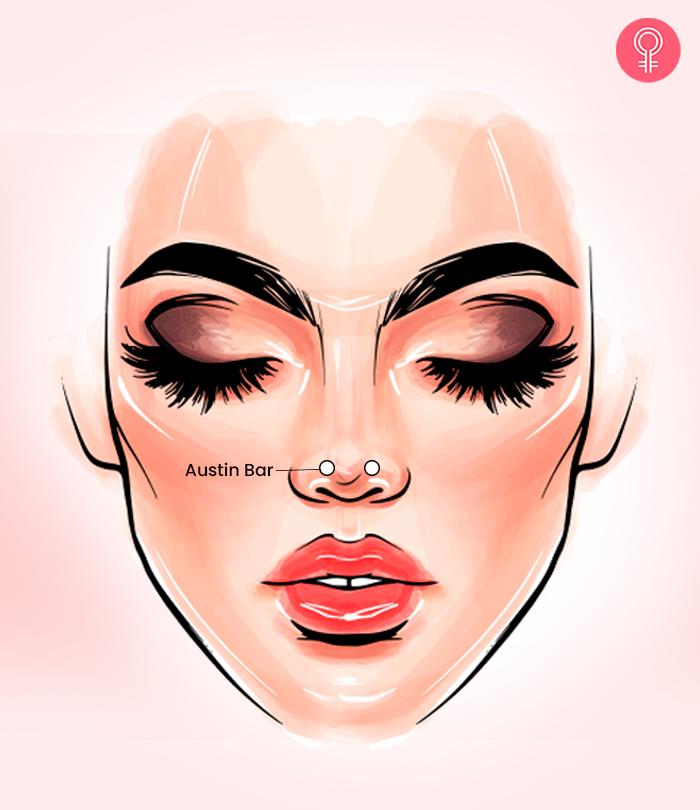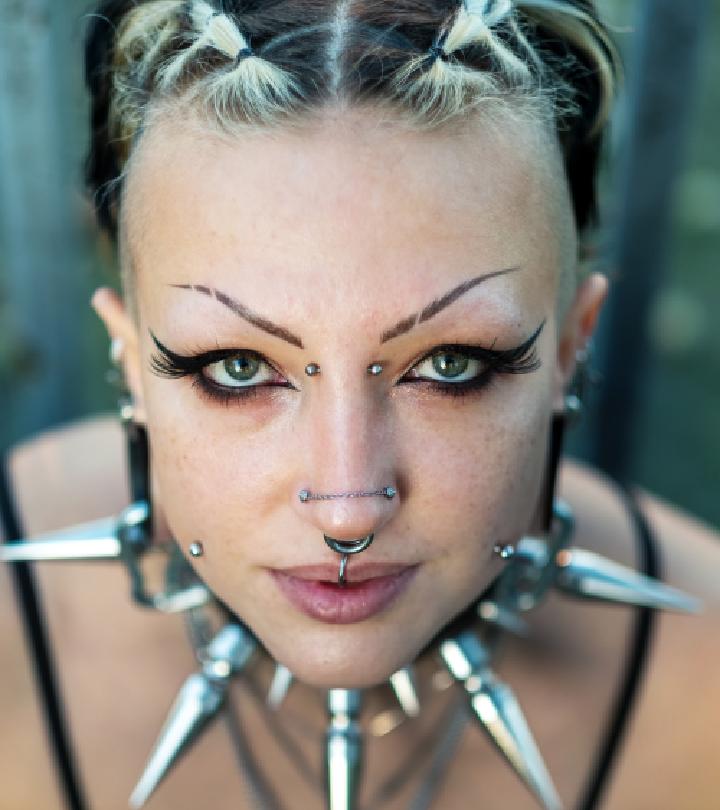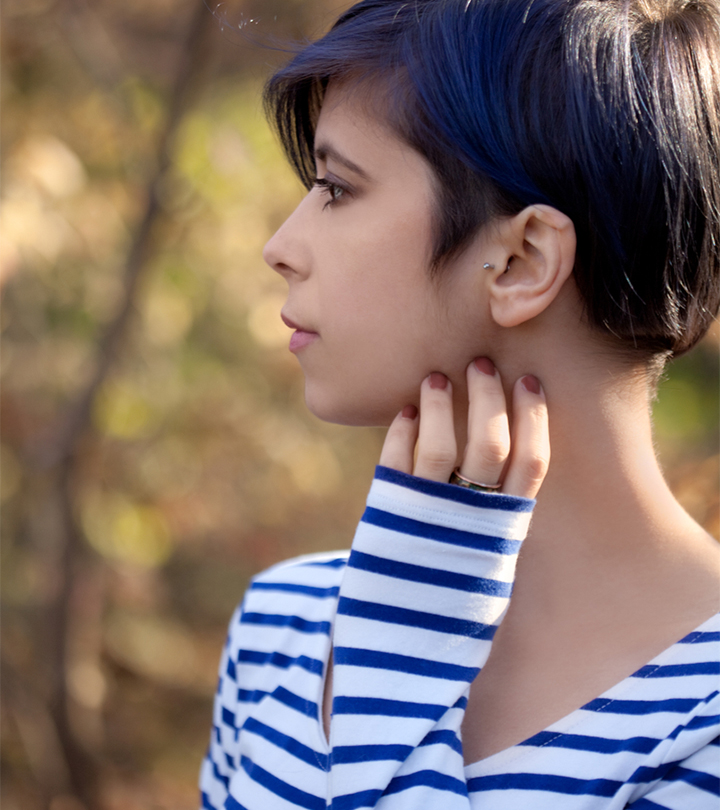Tongue Piercing: Types, Cost, Pain Level, And Aftercare
The one piercing that highlights your personality and presence like nothing else.

Image: Shutterstock
If you are into piercings and want to celebrate your daring, edgy, and outspoken personality, a tongue piercing could be the ideal choice. This body adornment helps you represent your rebellious side. However, the tongue is a sensitive body part and tongue piercings have certain potential risks – including infection, nerve damage, and dental issues. Hence, understanding tongue piercings further, including their types, pain levels, healing time, and aftercare routine is crucial. Continue reading to learn everything you need to know about tongue piercings and make an informed decision about them before you get one.
 Piercing Guide: Tongue Piercing
Piercing Guide: Tongue Piercing- Placement: Through the center of the tongue
- Best Jewelry: Straight barbells
- Cost: $30 to $100
- Pain Level: Moderate to high
- Healing Time: 4 to 6 weeks
In This Article
What Is A Tongue Piercing?
A tongue piercing involves puncturing the middle of the tongue and inserting jewelry, like a barbell, through the hole. This piercing can symbolize individuality, rebellion, sensuality, and communication. While it can be done in many forms, the two most common types are midline (vertical) and horizontal piercings. The midline piercing passes through the tongue’s center, from top to bottom; and the horizontal piercing runs from side to side, through the tongue.
 Trivia
TriviaTongue piercings are available in a lot more types and variants, and knowing about them can help you decide what suits your personality and style the best. Learn more about these types in the next section.
What Are The Types Of Tongue Piercings?
The most popular categories of tongue piercings are as follows:
- Tongue Frenulum Piercing
View this post on Instagram
It is also referred to as the tongue web piercing. It passes through the frenulum, or the thin portion of tissue underneath the tongue. This tissue connects the underside of the tongue to the floor of the mouth.
- Snake Eyes Piercing
View this post on Instagram
This is also known as venom piercing. It is an oral piercing where a barbell is pierced horizontally through the tip of the tongue. The piercing, when done, looks like a snake’s eyes.
- Frog Eyes Piercing
View this post on Instagram
Similar to a snake eyes piercing, a frog eyes piercing involves piercing the tongue horizontally with a barbell. This piercing is done a little above the tip of the tongue. It resembles the eyes of a frog, and hence the name.
- Uvula Piercing
This piercing is done on the uvula, the little, fleshy tissue that hangs down at the back of the throat. However, this piercing is extremely rare due to the uvula’s sensitive and delicate nature and the potential risks associated with it.
- Scoop Piercing
View this post on Instagram
In a scoop piercing, a curved barbell is pierced horizontally into the tongue. In contrast to conventional tongue piercings that are usually positioned vertically through the tongue’s center, scoop piercings are positioned horizontally and close to the tongue’s tip.
While tongue piercings are popular, they also can be painful. Understanding the pain level can help you prepare yourself for a tongue piercing session, should you want to get a piercing. Learn more about the same in the next section.
Pain Levels: How Bad Does A Tongue Piercing Hurt?
No piercing is without pain. Each person’s experience with tongue piercings may vary depending on their pain tolerance. While some people may describe the sensation as minimal, others may find it more intense. Individual pain thresholds, anxiety levels, and the piercer’s skill are factors that can determine the pain level.
Generally, the piercing itself is relatively quick and lasts only a few seconds. A majority of people claim that they feel a strong pinch or pressure while getting their tongues pierced. The discomfort may significantly worsen after the piercing when the adrenaline wears off. The tongue may feel sore, irritated, or swollen for a few days.
Becca-Louise, a blogger, shared her tongue-piercing experience in her personal blog. She writes, “I had the jewelry put in (an 18 mm bar), and I could feel my tongue starting to swell, a couple of minutes later I started talking with a lisp. I did struggle, but it wasn’t painful to the point it was unbearable to eat. I stuck to my cleaning routine and rinsed my mouth out after each meal (i).”
Besides the pain, how long a piercing takes to heal is another important factor that helps one decide if they should go for it. Also, being aware of the healing procedure and the timelines involved help with quicker recovery. Let us learn more about the same in the following section.
How Long Does A Tongue Piercing Take To Heal?
How long a tongue piercing takes to heal depends on one’s general health, how well they take care of the piercing, and how quickly their body heals. A tongue piercing usually takes four to six weeks to heal initially. However, the tissue inside the piercing site may take longer to strengthen and heal.
Maintaining a good aftercare routine for a few months following the first healing phase reduces the risk of infections and ensures the piercing fully matures. Maintaining proper dental hygiene and refraining from taking alcohol or smoking are key.
Observe the piercing for any signs of infection or other problems. Adhere to the aftercare measures recommended by the piercer. In addition, seek advice from a medical professional or your piercer if you have prolonged discomfort, swelling, redness, discharge, or any other serious symptoms.
 Trivia
TriviaWhen thinking about the healing period for a tongue piercing, who wouldn’t want to know how to minimize it. Properly following the right aftercare practices can help in this regard. While we briefly touched upon them earlier, let’s explore them more elaborately in the next section.
Tongue Piercing Aftercare
A proper aftercare routine is essential for healing a tongue piercing and reducing the risk of complications. Following are some general instructions to adhere to:
- Rinse your mouth with a saline solution or non-alcoholic mouthwash at least twice a day, particularly right after meals and before bed. This keeps the piercing area sterile and bacteria-free.
- Avoid using tobacco products and alcohol while the piercing is healing as they can otherwise irritate it and increase infection risk.
- Steer clear of foods that are hard, hot, spicy, or acidic. These may irritate the piercing or get trapped in the jewelry. Stick to soft, bland foods and chew carefully to avoid biting down on the jewelry.
- Gently wash your teeth twice a day with a soft-bristled toothbrush. Avoid the area where the piercing is located. After brushing, properly rinse your mouth with water to get rid of any toothpaste residue.
- Avoid kissing and any other such oral activities during the initial healing period to minimize the risk of introducing bacteria into the piercing site.
- Avoid touching or playing with the jewelry to prevent irritation and reduce the risk of infection. Also, wash your hands well before adjusting the jewelry.
- Swelling occurs after a tongue piercing and is common. Rinse your mouth with ice water and suck on ice chips or drink cold beverages to minimize swelling.
- Set up follow-up appointments with your piercer as advised to track the healing process and resolve any concerns or complications.
An understanding of the piercing process and aftercare tips can help you navigate the tongue piercing journey more smoothly. That said, tongue piercings have their set of advantages and disadvantages. It is important you examine them before you get a piercing done. Continue reading to learn more.
Pros And Cons Of A Tongue Piercing
Tongue piercings, like any other piercing, come with both advantages and disadvantages. Knowing about them is another step towards making an informed decision.
Pros
- In addition to being aesthetically stunning, tongue piercings can improve a person’s look and promote individuality and self-expression.
- Anecdotal evidence suggests that tongue piercings may increase pleasure during oral activities as the jewelry can provide additional stimulation. However, research is limited in this regard.
Cons
- Swelling is a common side effect of a tongue piercing due to the amount of daily activity a tongue goes through.
- There is a risk of infection with tongue piercings, especially if proper aftercare protocols are not followed. Pain, bleeding, swelling, and tenderness are symptoms of infection. In rare cases, a person may also develop a more serious infection like an abscess (1).
- Tongue piercings can result in gum recession and broken or cracked teeth if the jewelry comes in contact with the teeth or gums.
- Some people who get tongue piercings may develop short- or long-term speech impairments. These include lisping or trouble pronouncing specific sounds.
- Lack of proper oral hygiene may increase the risk of oral health issues like gum recession (2).
- As with every other piercing, tongue piercings have a risk of rejection or migration where the body pushes the jewelry out or the piercing shifts from its placement.
- In some cases, accidentally ingesting the jewelry may result in throat injury or choking.
Although a tongue piercing can be a stylish way to express oneself, it is important to put safety first to reduce risks. Following are a few safety measures to follow.
Tongue Piercing Safety Measures
It is essential to implement safety measures before, during, and after a tongue piercing to minimize risks and promote proper healing. Here are some key safety measures to consider:
Choose a piercer who works in a hygienic and clean atmosphere and has the required experience and license. Consult friends for suggestions or look through reviews to identify a reputable piercer.
- Prior to the procedure, ensure that every piece of jewelry, tool, and needle to be used is thoroughly sanitized and wrapped.
- Select high-quality, hypoallergenic jewelry composed of titanium or surgical-grade stainless steel. Avoid jewelry made of nickel as it may trigger allergic responses.
- Carefully follow your piercer’s aftercare instructions to promote healing and minimize the risk of infection. Some such practices may include using a saline solution to rinse the piercings, avoiding spicy foods, and maintaining proper dental hygiene.
- Keep an eye on the piercing site if you notice any symptoms of infection like increasing pain, swelling, redness, warmth, or discharge. Get help from your piercer or a medical expert if the symptoms persist or aggravate.
- Avoid kissing, other oral activities, and sharing utensils or beverages to reduce the risk of bacterial accumulation in the piercing site during the initial healing phase.
- Make any necessary follow-up appointments with your piercer to check on the healing process and discuss any concerns.
These safety measures help reduce the risk of infections. They also re-emphasize the importance of choosing the right jewelry material for your tongue piercing. Two such materials appear to stand out and offer reasonable safety. Learn more about them in the next section.
What Jewelry Material Is Used For A Tongue Piercing?
The right material for tongue piercings help maintain oral health and reduce the risk of infections. Two such materials are implant-grade stainless steel and titanium.
- Implant-Grade Stainless Steel: This is a popular material for body piercings, including tongue piercings. It is also known as surgical stainless steel, and is often chosen for its biocompatibility, corrosion resistance, and durability.
- Titanium: Titanium doesn’t include nickel, and hence won’t irritate the piercing area or cause any allergic reactions. Titanium is lightweight, non-corrosive, and available in a variety of colors and designs.
Some piercers may use biocompatible plastics, like PTFE (polytetrafluoroethylene) or acrylic, for tongue-piercing jewelry. In addition, high-quality, nickel-free gold jewelry may also be used for tongue piercings.
Knowing what materials are appropriate for tongue piercings allows people to explore the range of jewelry options and enables them to make well-informed decisions that support their comfort and taste. Continue reading to learn about the different types of jewelry used for tongue piercings.
What Type Of Jewelry Is Used For A Tongue Piercing?
A straight barbell is the most popular jewelry type used for tongue piercings. It has a ball or bead at each end of a straight rod. The barbell is fastened in place by screwing the beads or balls onto its ends. This piercing not only reduces the risk of discomfort or harm to the teeth and gums, but also offers stability. Usually, the thickness of the tongue determines the length of the barbell.
Some people may decide to add unique bead forms, colors, or materials to their tongue piercing jewelry. However, one must ensure that these decorative components are made of materials that are safe and securely attached.
Beyond the jewelry material and type, the price of a tongue piercing is another important aspect to consider. Understanding the pricing will give you a clear picture of the investment involved. Read on to know more about it.
How Much Does A Tongue Piercing Cost?
A tongue piercing’s cost can vary based on several factors, such as the location of the piercing studio, the piercer’s skill and reputation, the kind of jewelry used, and any extra services or aftercare items offered. On average, you can expect to pay anywhere between $30 and $100 or more for a tongue piercing.
Certain piercers may offer package discounts that cover the cost of the jewelry and aftercare items within the piercing fee. Others may charge extra for both. But it is always better to choose a reputable piercer who emphasizes safety and hygiene, even if that means paying a little more.
Tongue piercings serve as a unique form of self-expression, and many people enjoy their aesthetic appearance and cultural significance. However, one also needs to recognize their potential complications, including infection, swelling, nerve damage, and dental issues. Maintaining good oral hygiene and following aftercare instructions properly may help minimize these risks. However, should you still experience any discomfort, consult with your piercing expert or medical professional for support and guidance.
Frequently Asked Questions
Can anyone get a tongue piercing?
Yes. Anyone can get a tongue piercing. However, one must consider their oral health, tongue anatomy, personal habits (like smoking), commitment to aftercare, and susceptibility to metal allergies before getting one. In addition, speaking with a qualified piercer can help one receive personalized guidance.
When can I change my tongue piercing?
The timing for changing a tongue piercing can vary depending on how long your piercing takes to heal and your piercer’s advice. Typically, it is recommended to wait for 6 to 8 weeks before changing your tongue piercing, after ensuring it is fully healed.
How to change out a tongue piercing?
Start by carefully removing the previous jewelry by gently taking it out and unscrewing the balls or discs. Now carefully place the new jewelry into the piercing hole and fasten it with the balls or discs. Ensure you maintain hygiene throughout the process.
What gauge is a tongue piercing?
Standard tongue piercing gauges range between 14 gauge (1.6 mm) and 12 gauge (2.0 mm). However, there could be some variations based on the piercer’s recommendations and personal taste.
What to do if I don’t want my tongue piercing anymore?
Consult a qualified piercer who has the right tools to safely remove the jewelry from your tongue piercing. Clean the area following removal and follow the aftercare instructions to promote healing and reduce the risk of problems.
What should you consider when choosing a piercing for your tongue?
Make sure the tongue piercing you choose is suitable for your body type and way of life. Consider aspects like the size, placement, and type of jewelry. Prioritize hygiene and professionalism. Opt for reputable piercing studios and discuss your concerns with a licensed piercer before you proceed further.
Key Takeaways
- A tongue piercing is a form of self-expression and cultural statement for many people.
- Although tongue piercings are visually striking, lack of proper aftercare can cause infections, dental issues, allergic reactions, and speech impediments.
- Consult with experienced piercers, maintain proper hygiene, choose high-quality jewelry, and follow proper aftercare instructions for a successful piercing experience.
Thinking of getting your tongue pierced? Watch this insightful video and discover what to expect! Prepare for your piercing journey today.
Personal Experience: Source
StyleCraze's articles are interwoven with authentic personal narratives that provide depth and resonance to our content. Below are the sources of the personal accounts referenced in this article.
(i) Tongue Piercing
https://beccaalouise.wordpress.com/2015/08/16/tongue-piercing/
References
Articles on StyleCraze are backed by verified information from peer-reviewed and academic research papers, reputed organizations, research institutions, and medical associations to ensure accuracy and relevance. Read our editorial policy to learn more.
- Bacterial infections complicating tongue piercing
https://www.ncbi.nlm.nih.gov/pmc/articles/PMC2852294/ - The incidence of complications associated with lip and/or tongue piercings: a systematic review
https://pubmed.ncbi.nlm.nih.gov/25690049/
Read full bio of Anjali Sayee
Read full bio of Shreya Mukherjee




